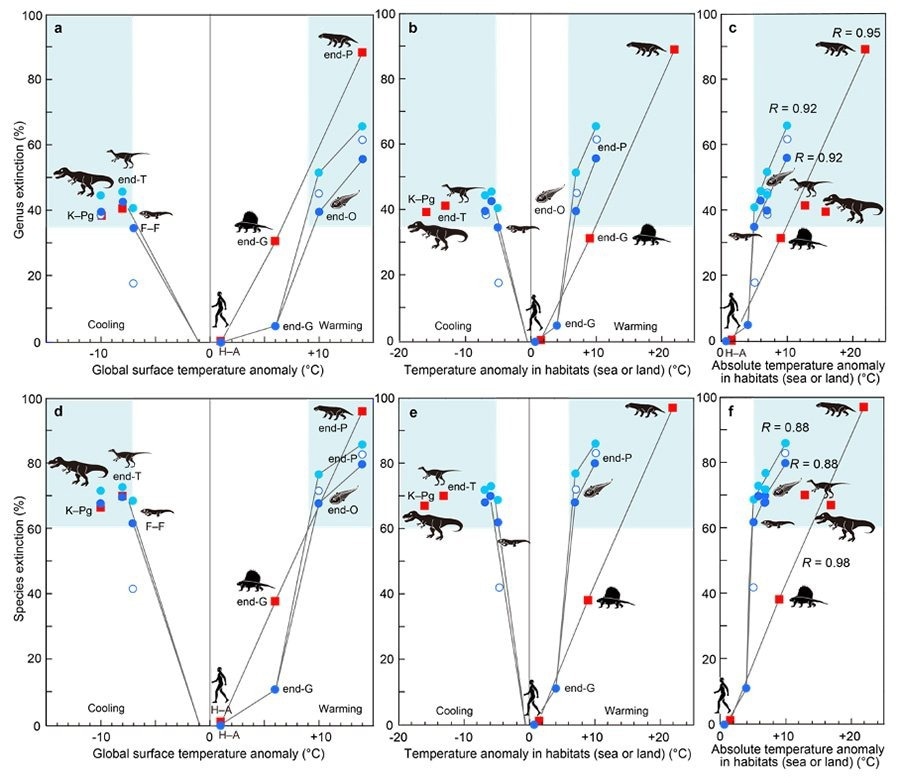Reviewed by Alex SmithJul 25 2022
A Tohoku University professor emeritus has found proof of a significant connection between the magnitude of mass extinctions and global temperature changes throughout geologic time.
 The relationship between genus and species extinction percentage and surface temperature anomaly in major mass extinctions from the end-Guadalupian crisis, and the current crisis in the Anthropocene. Image Credit: ©Kunio Kaiho et al.
The relationship between genus and species extinction percentage and surface temperature anomaly in major mass extinctions from the end-Guadalupian crisis, and the current crisis in the Anthropocene. Image Credit: ©Kunio Kaiho et al.
On July 22nd, 2022, the study was published in the journal Biogeosciences.
Throughout the Phanerozoic Eon (539 million years to the present), unexpected climate change, combined with environmental collapse caused by massive volcanic eruptions and meteorites, has resulted in major mass extinctions.
There have been very few quantitative assessments of the connection between land temperature anomalies and terrestrial animal disappearance to date. Furthermore, marine and terrestrial animals have encountered wildly different extinction rates, which are still unknown.
Professor Emeritus Kunio Kaiho proved that the extinction rates of marine invertebrates and terrestrial tetrapods coincided with variations in global and habitat surface temperatures, irrespective of whether they were cooling or warming.
Loss of species during the “big five” significant extinctions was associated with a >7 °C global cooling and a >7-9 °C global warming for marine animals and a >7 °C global warming for terrestrial tetrapods.
These findings indicate that the bigger the shifts in climate, the larger the mass extinction. They also tell us that any prospective extinction related to human activity will not be of the same proportions when the extinction magnitude changes in conjunction with global surface temperature anomaly.
Kunio Kaiho, Professor Emeritus, Tohoku University Creating Global Excellence
According to Kaiho, a 5.2 °C temperature rise in overall global temperature would lead to a mass extinction event similar to the previous ones. However, according to the findings of this study, the temperature must rise by 9 °C, which will not occur until 2500 in the worst-case scenario.
“Although predicting the extent of future extinctions is difficult because causes will differ from preceding ones, there is sufficient evidence to suggest that any forthcoming extinction will not reach past magnitudes if global surface temperature anomalies and other environmental anomalies correspondingly change,” Kaiho said.
Kaiho also discovered that terrestrial tetrapods have a lower tolerance for global warming events than marine animals. However, marine animals were less tolerant of the same temperature variations as terrestrial animals. This is because the temperature anomaly on land is 2.2 times greater than the sea surface temperature. These occurrences are consistent with continual extinction patterns.
Looking forward, Kaiho hopes to forecast future animal extinction magnitudes between 2000 and 2500.
Journal Reference:
Kaiho, K., et al. (2022) Relationship between extinction magnitude and climate change during major marine and terrestrial animal crises. Biogeosciences. doi.org/10.5194/bg-19-3369-2022.